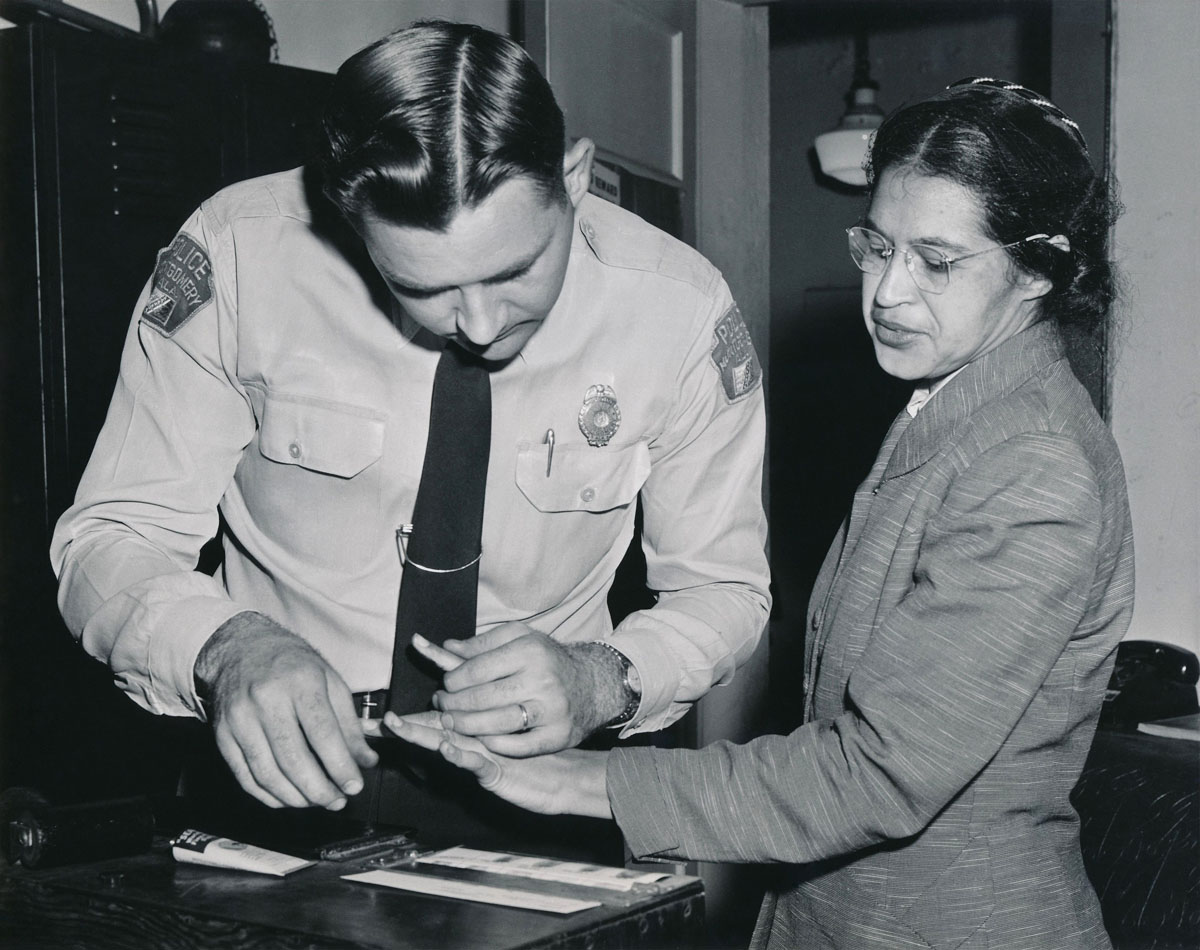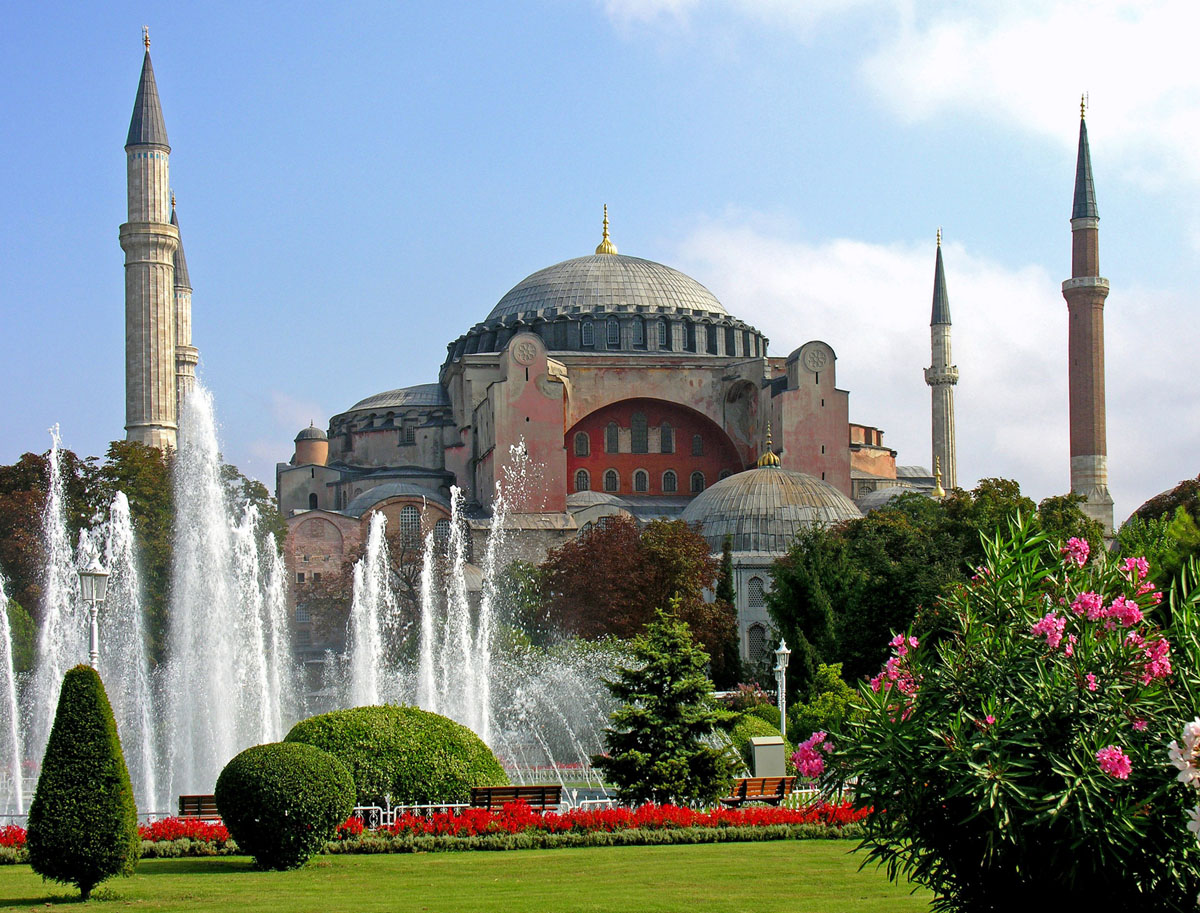Needed: An honorable calculus of civility and incivility

Rosa Parks is fingerprinted after she was arrested for refusing to give up her seat on a bus to a white person, 1956, Montgomery, Alabama. Wikipedia photo.
Here are some sample problems to solve with a calculus of civility and incivility. What do you think?:
1. If a friend of a friend on Facebook trolls liberals by repeating a false and racist right-wing talking point, should every liberal within hearing distance let him have it with both barrels?
2. If a liberal walks into an auto parts store in a rural red county, and a man behind the counter is in the middle of loudly repeating a racist lie about Barack Obama, should the liberal say, loud enough for the man behind the counter to hear, “Watch it! Democrat in the room!” Then should the liberal engage the man, as briefly as possible, to expose for all within earshot what a dumbass little POS bigot the man behind the counter is?
3. Should a liberal discuss politics with Republican neighbors, or at holiday dinner tables with right-wing relatives?
These kinds of questions are frequently on our minds, and often we find ourselves in situations in which we have only a moment to speak up or not to speak up, and, if we speak, to decide what to say. But rarely is the question discussed in a thoughtful — I’ll even say rigorous — way. Today the Atlantic’s web site has a much-needed article on this subject by Adam Serwer, “Civility Is Overrated: The gravest danger to American democracy isn’t an excess of vitriol — it’s the false promise of civility.”
I cannot claim that my own thinking has been rigorous, but I’ve given this some thought, and I’ve parted company with my fellow liberals (such as Joe Biden?) who would argue that we should “reach out” to these people and try to preserve or restore civility. My view is that the Republican Party under the influence of Trump has become so openly and proudly racist, so delusional, and so damned mean that to remain silent in the name of civility would be a moral failing and a political mistake. I do not propose that we bait right-wing racists or troll them. I propose only that we respond when they lash out, even at the expense of civility.
I think I will not attempt to summarize Serwar’s case here; I’d encourage everyone to read this piece. But I would like to mention one of the political angles that Serwar worries about, which is that if the Democratic Party ends up losing to Republicans in 2020, then the Democratic Party might then try to “reach out” to white rural conservatives for the sake of political power and civility at whatever cost, while turning its back on principles of justice and equality, and on constituents that rural white conservatives don’t like. If that ever happened, I would be among the first to leave the Democratic Party. I do not want to be in the same party as rural, white, racist evangelicals. They could not possibly fit into the Democratic coalition unless others were pushed out. That is part of Serwer’s point in the Atlantic article.
My views, I hope, are always subject to rethinking and revision. But here is how I would reply to the three questions above.
1. Yes. Let the Facebook troll have it with both barrels and then some, even if it makes a scene.
2. Yes. Let the man behind the counter have it with both barrels and then some, even if it makes a scene.
3. Not talking politics in mixed company is a perfectly acceptable solution. With my neighbors, what works is to concern ourselves with local matters about which party politics and the polarized state of the nation have nothing to say. We talk about our common concerns, such as how our unpaved road is holding up in winter weather, or who needs firewood. None of my Republican neighbors has ever baited me. However, right-wing baiting and trolling clearly happens at holiday dinner tables all over the country. The calculus to apply, I’m thinking, probably will vary from family to family. Responding with both barrels is an option, but I would not argue that it’s obligatory in all situations. In other words, it’s a complex calculus, and we need to work on it, recognizing that the best answer at some Christmas dinner tables may not be the best answer in our state and national politics, a zone in which we must talk politics.
Update: Today at the Guardian, a columnist wonders whether civility was the wrong call: “The life lessons I learned over breakfast with a Trump supporter.”
Hastening their own demise

The Hagia Sophia in Istanbul, now a museum. Wikipedia photo.
The Economist has an article today with the headline “Arabs are losing faith in religious parties and leaders.” The article reports not only a sharply declining trust of religion in politics in the Arab world, but also that Arab young people are losing their religious zeal. This mirrors what is happening in the United States, as young people increasingly reject religion.
There is a reason why Islam and Christianity — two peas in a pod that hate each other because they’re so much alike — are the most dangerous religions in the world and why they’re the two religions that produce almost all of the radicals. It’s that Islam and Christianity are proselytizing religions, with doctrine that claims a divine mandate to spread and rule the world.
Two days ago, the Washington Post carried yet another article on yet another lord of the Catholic church taken down because of the sexual abuse of children. Most of the comments on this article were vicious. For example:
Tax all of these hideous rape cults out of existence.
It seems to me that the catholic church has become nothing more than a criminal enterprise.
Put these men of god in jail.
And then there are the American “evangelicals.” As much as I dislike Facebook memes, I came across a good one a couple of days ago:
Republican logic: God, who didn’t get personally involved during the Holocaust, two World Wars, Chernobyl, Sandy Hook, the Bhopal disaster, Hurricane Maria, the Armenian genocide, and the destruction of Pompeii, intervened in a U.S. election so Donald Trump would become president.
The more these religions lash out at the rest of us to try to save themselves, the more they expose why decent people don’t want to be in them. Their best hope for a future, really, would be to stop proselytizing, to try to quietly live the nicer parts of their doctrine, to leave the rest of us alone, and to settle for a fair share of the world rather than demanding all of it. American evangelicals, craving earthly dominion, think that Trump will save them. The opposite is much more likely: that Trump will figure heavily in the obituary of the Protestant church in America.
If religionists didn’t have blind spots, they wouldn’t be religionists. They blame the rest of us for their diminishing numbers, unable to see themselves as others see them. At the grassroots level, religionists in these parts have a new micro-aggression, micro-method of proselytizing, and micro-method of virtue-signaling that has been spreading for a few years now: “Have a blessed day.” I have never responded impolitely. There is no good comeback, and they know it. But they are not capable of perceiving the amount of quiet disgust that their virtue-signaling is generating in those who are not in their cult. Whether with the shovels of a Catholic criminality or the deification of Trump, or by the spoonful with little words, they are digging a hole that someday will be big enough for their church.
Update: FiveThirtyEight: Millennials are Leaving Religion and Not Coming Back
Battlestar Galactica
My shortlist of the best television ever made would include Battlestar Galactica, which ran on the Syfy channel from 2003 until 2009. And guess what: It’s coming back.
In September, the Hollywood Reporter and other news outlets reported that NBCUniversal will produce a new take on Battlestar Galactica for its Peacock streaming service. The new series is to be based on the Syfy series but will explore new storylines.
The 2003-2009 Syfy series coincided with my last years in San Francisco. Those post-9/11 years were extremely stressful not only for me, but for millions of people, particularly city dwellers. Traumatized by 9/11, we saw the election of the empty and belligerent George Bush and Dick Cheney, who lost no time in dragging the country into an insane war, a financial bubble, and a deep recession. Battlestar Galactica was a weekly dose of courage for those of us who are too smart and too kind to suffer Republican governments. Though the characters were constantly under attack and never got a break, they somehow kept going. The writing was superb, and the casting and cast chemistry were perfect. Oh, how we wished for a president like Mary McDonnell’s Laura Roslin.
I have been rewatching Battlestar Galactica for the first time, and though I remember virtually every scene and remember lots of the lines, it’s still thrilling. The cast are like old friends. You can stream the series for free if you have Amazon Prime video.
Game of Thrones left us all too soon, with too little to fortify us against the ugliness of the era. Note to the movie industry: Please don’t let that happen again. We need an escape, and something to buck us up, until the tide turns.
Update: As of a day or two ago, Battlestar Galactica is no longer available free on Amazon Prime. They’re charging $35 to $40 a season!
The duties of decency
One of the things that astonishes me and scares the daylights out of me, while watching the House impeachment hearings, is what the Republican Party has become. The vileness and just plain meanness of Reps. Jim Jordan and Devin Nunes are on full display as they spit and rant and bully to create sound bites for Fox News. But to Republicans, the two of them are heroes and leaders.
I have written here before about the American psychologist Jonathan Haidt and how he has tried to convince us that liberals and conservative have equal — just different — claims on virtue. Haidt actually convinced me of the opposite: that conservatives’ love of authority, their fixation on purity (where pure means just like them), and their fear and distrust of out-groups puts conservatives in constant moral peril. But it’s even worse than that, because it’s all too easy for the authority that conservatives crave to whip up their fears and suspicions and make them a danger to everyone else.
Paul Krugman, in today’s column in the New York Times, writes that Republicans are proving that there is no bottom to their corruption. Krugman writes, “I don’t think most observers realize, even now, the extent to which many Republicans view their domestic opponents not as fellow citizens but as enemies with no legitimate right to govern.”
I realize it, all right. A few days ago, in the Facebook group of the Republican Party in my county, a Republican wrote: “Too many people on the right think that the Democrats of today are good people with bad ideas. That is no longer true. They are evil people, not worthy of this country, and we need to be plotting how to forcibly deport them to Greenland, etc.” Among those who “liked” this comment were two Republicans who are running for county commissioner. This is the kind of thinking that Fox News has retailed into the provinces.
But what I want to write about here is the survival of decency when authoritarians are so corrupted and so off the rails that the American democracy is in great danger. Normally, the people who work inside the “Deep State” are anonymous and invisible to those of us who don’t work in Washington. The impeachment hearings have given names and faces to some of them — Fiona Hill, David Holmes, Lt. Col. Alexander Vindman, Marie Yovanovich. People such as them, because of their decency and their professional ethics, have to be shoved aside for corruption to have its way. Trump slanders them. And the likes of Jim Jordan and Devin Nunes slander them to defend Trump. It is sickening to watch.
Liberals, with their focus on fairness, justice, and kindness, are in a terrible position when conservatism becomes corrupt and dangerous. How do you stop them without becoming just like them? The last defense, of course, is the law.
Adam Schiff’s closing comments yesterday were as perfect an expression of decency — and the duties of decency — as I can imagine. This video is 20 minutes long; make yourself a cup of tea. I can’t help but think that it would be horrible to be a conservative, blindly in thrall to a con man like Donald Trump, with such a sorry and corruptible sense of virtue. Schiff’s words are a great comfort to those of us whose good fortune it is not to be like that.
At last we see the tip of the iceberg
For those of us who have been paying careful attention to the crimes and treason of Donald Trump and connecting the dots as best we can, this morning was a milestone. When Gordon Sondland, in his opening statement to the House Intelligence Committee, threw everyone under the bus — Trump, Pence, Pompeo and all — we moved from the dot-connecting stage to at last seeing the tip of the iceberg.
If the American democracy remains strong enough to do its job, then just the tip of that iceberg is sufficient to remove Trump from office, along with his vice president (Mike Pence), secretary of energy (Mike Pompeo), chief of staff (Mick Mulvaney), secretary of state (Rick Perry), and personal lawyer (Rudy Giuliani), all of whom Sondland forcefully threw under the bus this morning.
But as disgusting as the tip-of-the-iceberg crimes are that Sondland described, it’s the still-hidden crimes down in the iceberg itself that really matter and that are truly dangerous. Those crimes revolve around the fact that this whole Ukraine affair is not really Donald Trump’s foreign policy. It’s Russia’s foreign policy. It’s not as though Trump and friends have been conspiring to bully some small country far outside Russia’s orbit. They’ve been conspiring to bully Ukraine, which is of critical strategic importance as a firewall between Russia and the western alliance. Donald Trump and Rudy Giuliani are petty and provincial American crime figures with no particular knowledge of or interest in foreign affairs other than where there is money to be skimmed and payola to be grifted. Trump and Giuliani have no motives for being concerned about Ukraine, other than whatever money they or their cronies might be skimming. But who is concerned about Ukraine? Vladimir Putin, of course. Who other than Putin could have designed this little plot? Who benefits? As Nancy Pelosi said, all roads lead to Putin.
It follows that the urgent questions now are: How did Putin communicate this plan to Trump? Why was Trump obligated to attempt to execute Putin’s plan?
Another angle that is (for now, anyway) being ignored by the media is: Trump and friends, by crushing the Mueller investigation, thought that they had gotten away with stealing the 2016 election, with help from Russia. The plan for stealing the 2020 election involved exactly the same modus operandi — lies and conspiracy theories about the Democratic opponent. Rudimentary dot-connecting shows that catching them in the act of treason involving the 2020 election pretty much convicts them of their treason in the 2016 election.
Even when Trump and friends go down for the Ukraine affair, we’ll be nowhere near getting to the bottom of their crimes and treason. It’s not just that the executive branch of the American government has fallen into the hands of a crime syndicate. It’s that it’s an international crime syndicate in which Vladimir Putin is the big boss and Donald J. Trump is just another goon.
Barley twist
I recently came into possession of this strange table, which belonged to my grandparents. Frankly I find the table somewhat ugly. But I’m amused by the eccentricity and whimsy. To try to find out about the style, I Googled for “double helix furniture.” That turned up lots of images of antique furniture and revealed that the style is called “barley twist.”
Judging from online photos, most barley twist is found in the legs of a table or the posts of a bed. The central double helix post of this table is less common. Barley twist furniture is not as hard to find as I thought it might be. According to online sources such as this one, barley twist first showed up in France in the 1600s. It apparently was popular in the 1800’s, and some custom furniture makers are still doing it. I’m still confused, though, about how it’s done. My guess is that it’s started on a lathe and then carved. There may even be some twisting involved for all I know.
This table is walnut, including the balls in the claw feet. It now sits by a north-facing window and supports a globe.
Beyond Sausage vegan bratwurst

Beyond Sausage bratwurst, sweet and sour Brussels sprouts, and potato salad
Beyond Meat’s bratwurst was on sale at a grocery store in Madison, so I decided to try it.
Was it awesome? Not really. In taste and bite and texture, it was a lot like vegan cold cuts that have been on the market for a long time. Still, it was good, with a nice meaty bite. And, at the right price, it’s a good high-protein meal, with 22 grams of protein and only 190 calories per brat.
It surprises me how quickly these new meat alternatives have become available, even in provincial grocery stores. Most provincial shoppers won’t buy it, which is why it goes on sale. Their thinking is entirely reasonable, I think. Why pay more for pea protein than for animal sausage?
I would like to think that these meat substitutes will be less expensive than meat before long, as they ought to be. Then we’ll be making progress. A day will come, I think — maybe sooner than we expect — when children will be horrified to hear that people used to kill and eat animals.
Mrs. Squirrel
Fried barley?

Good-bye garden stir fry with fried barley
For the longest time, I had been planning to see if fried barley can compete with fried rice. Yes it can.
The chewy texture of barley makes great fried rice. The grains are sturdy and are not at risk of turning to mush when thrown around in the wok. The grains love a thin coating of sauce, but they don’t drink it up the way rice does. You’ll eat less, because barley takes longer to chew.
The stir fry above contains lots of green peppers and green tomatoes given to me by a neighbor. They had picked the last remaining parts of their garden (which was a lot) before the first freeze. Green tomatoes are brilliant in a stir fry or curry.






